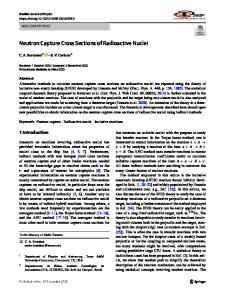Maximum Cross Sections for Excited State and Two-Photon Absorption
- PDF / 1,381,314 Bytes
- 12 Pages / 417.6 x 639 pts Page_size
- 73 Downloads / 341 Views
remained hopeful that breakthroughs to much higher cross sections were achievable, it seemed useful to ascertain what the upper limit on performance might be. This would give designers a basis for projecting future performance, and help synthetic chemists to focus on materials properties amenable to improvement. Perhaps the most critical factor governing the performance of an RSA limiter is the magnitude of the excited state cross section. Other factors, such as the ratio of the excited state to ground state cross sections, are also important, but the excited state cross section determines the ceiling for performance. At present this ceiling is uncomfortably low. Generally speaking authors quote only cross sections at specific wavelengths rather than integrated cross sections. The largest cross sections occur for highly resonant transitions where the linewidths are narrow Efforts to extend the bandwidth from the narrow range of about 3000 cm-1 or even less out of 19,000 cm-1 have met with greatly reduced excited state cross sections. This raises the question of whether some fundamental limit is being reached, and the nature of any such a limit. This question is
now addressed. Little here is original. The proofs are taken from long-established text books and are well-established. Gaussian units are used here, bringing consistency with older texts which are helpful in formulating a generic treatment of the subject. I denote the optical electric field by F, the refractive index by n, and the speed of light in vacuum by c. E will be reserved for energy. The notation for the Poynting vector S, varies. This can lead to differences in formulations for intensities involving powers of 2. The magnitude of the Poynting vector is the intensity I. In Gaussian units the Poynting vector S for real fields takes the form
(1) S =cFxH =cnF2 47r 41c In the following discussion the extra factors occurring due to the use of SI units will be placed in square brackets, []. Factors pertaining to normalization in terms of the frequency v rather than the angular frequency o) will be denoted by standard brackets, 0. For example, the energy density u(o) is (2) u (ro)) = [2n] -• •F2 1(2)
41E
To conserve space this paper contains few references. A copious and detailed reference list is given in a manuscript in preparation CLASSICAL DESCRIPTION We begin the discussion with a classical derivation of the upper bound on an absorption cross section. The classical description of the polarizability of a molecule gives the maximum response; it leads to an oscillator strength of one per participating valence electron. Indeed, a classical description is commonly used in texts on nonlinear optics. A quantitative description of a suboptimal response requires a quantum treatment, and is covered in Section 3. The starting point is the connection between the absorption cross section and the imaginary part of the polarizability, o(O)c). By definition, the power loss t is given in terms of the intensity I by Et =_ . (3) Now the rate of energy loss t in a sma
Data Loading...











